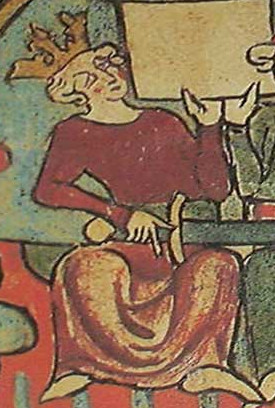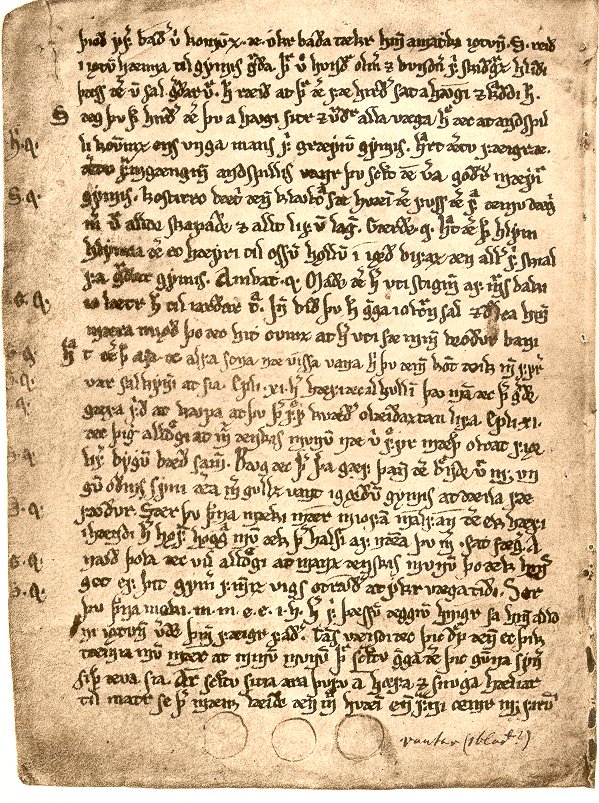|
Amícus Saga Ok Amilíus
''Amícus saga ok Amílius'' is a medieval Icelandic romance saga. Probably from the fourteenth century, it was translated from Vincent de Beauvais's ''Speculum historiale'', probably during the reign of Haakon V of Norway, and tells a similar story to the related French romance ''Amis et Amiles ''Amis et Amiles'' is an old French romance based on a widespread legend of friendship and sacrifice. In its earlier and simpler form it is the story of two friends, one of whom, Amis, was sick with leprosy because he had committed perjury to sav ...''. The saga survives in only one manuscript, Stockholm, Royal Library Perg 4to nr 6 (ca 1400). The saga has enjoyed extensive critical discussion.Marianne E. Kalinke and P. M. Mitchell, ''Bibliography of Old Norse–Icelandic Romances'', Islandica, 44 (Ithaca: Cornell University Press, 1985), pp. 23-24. Editions and translations * Kolbing, Eugen, ed. "Bruchstuck einer Amicus ok Amilius saga", ''Germania'', XIX (N.S. VII, 1874), 184–89. ... [...More Info...] [...Related Items...] OR: [Wikipedia] [Google] [Baidu] |
Romance Saga
The ''riddarasögur'' (literally 'sagas of knights', also known in English as 'chivalric sagas', 'romance-sagas', 'knights' sagas', 'sagas of chivalry') are Norse prose sagas of the romance genre. Starting in the thirteenth century with Norse translations of French '' chansons de geste'' and Latin romances and histories, the genre expanded in Iceland to indigenous creations in a similar style. While the ''riddarasögur'' were widely read in Iceland for many centuries they have traditionally been regarded as popular literature inferior in artistic quality to the Icelanders' sagas and other indigenous genres. Receiving little attention from scholars of Old Norse literature, many remain untranslated. The production of chivalric sagas in Scandinavia was focused on Norway in the thirteenth century and then Iceland in the fourteenth. Vernacular Danish and Swedish romances came to prominence rather later and were generally in verse; the most famous of these are the Eufemiavisorna, the ... [...More Info...] [...Related Items...] OR: [Wikipedia] [Google] [Baidu] |
Vincent De Beauvais
Vincent of Beauvais ( la, Vincentius Bellovacensis or ''Vincentius Burgundus''; c. 1264) was a Dominican friar at the Cistercian monastery of Royaumont Abbey, France. He is known mostly for his ''Speculum Maius'' (''Great mirror''), a major work of compilation that was widely read in the Middle Ages. Often retroactively described as an encyclopedia or as a ''florilegium'', his text exists as a core example of brief compendiums produced in medieval Europe. Biography The exact dates of his birth and death are unknown, and not much detail has surfaced concerning his career. Conjectures place him first in the house of the Dominicans at Paris between 1215 and 1220, and later at the Dominican monastery founded by Louis IX of France at Beauvais in Picardy. It is more certain, however, that he held the post of "reader" at the monastery of Royaumont on the Oise, not far from Paris, also founded by Louis IX, between 1228 and 1235. Around the late 1230s, Vincent had begun working on the '' ... [...More Info...] [...Related Items...] OR: [Wikipedia] [Google] [Baidu] |
Haakon V Of Norway
Haakon V Magnusson (10 April 1270 – 8 May 1319) ( non, Hákon Magnússon; no, Håkon Magnusson, label= Modern Norwegian) was king of Norway from 1299 until 1319. Biography Haakon was the younger surviving son of Magnus the Lawmender, King of Norway, and his wife Ingeborg of Denmark. Through his mother, he was a descendant of Eric IV, king of Denmark. In 1273, his elder brother, Eirik, was named junior king under the reign of their father, King Magnus. At the same time, Haakon was given the title "Duke of Norway", and from his father's death in 1280, ruled a large area around Oslo in Eastern Norway and Stavanger in the southwest, subordinate to King Eirik. Haakon succeeded to the royal throne when his older brother died without sons. In 1295, Haakon married firstly with Isabelle, daughter of Jean I, Count of Joigny, but she died in 1297 without children. His eldest daughter was Princess Agnes Haakonsdatter. Family connections between Haakon V and the later Østby fam ... [...More Info...] [...Related Items...] OR: [Wikipedia] [Google] [Baidu] |
Amis Et Amiles
''Amis et Amiles'' is an old French romance based on a widespread legend of friendship and sacrifice. In its earlier and simpler form it is the story of two friends, one of whom, Amis, was sick with leprosy because he had committed perjury to save his friend. A vision informed him that he could only be cured by bathing in the blood of Amiles's children. When Amiles learnt this he killed the children, who were, however, miraculously restored to life after the cure of Amis. The tale found its way into French literature through the medium of Latin, as the names Amicus and Amelius indicate, and was eventually attached to the Carolingian cycle in the 12th-century chanson de geste of Amis et Amiles. This poem is written in decasyllabic assonanced verse, each stanza being terminated by a short line. It belongs to the heroic period of French epic, containing some passages of great beauty, notably the episode of the slaying of the children, and maintains a high level of poetry throughout. ... [...More Info...] [...Related Items...] OR: [Wikipedia] [Google] [Baidu] |
Chivalric Sagas
The ''riddarasögur'' (literally 'sagas of knights', also known in English as 'chivalric sagas', 'romance-sagas', 'knights' sagas', 'sagas of chivalry') are Norse prose sagas of the romance genre. Starting in the thirteenth century with Norse translations of French ''chansons de geste'' and Latin romances and histories, the genre expanded in Iceland to indigenous creations in a similar style. While the ''riddarasögur'' were widely read in Iceland for many centuries they have traditionally been regarded as popular literature inferior in artistic quality to the Icelanders' sagas and other indigenous genres. Receiving little attention from scholars of Old Norse literature, many remain untranslated. The production of chivalric sagas in Scandinavia was focused on Norway in the thirteenth century and then Iceland in the fourteenth. Vernacular Danish and Swedish romances came to prominence rather later and were generally in verse; the most famous of these are the Eufemiavisorna, thems ... [...More Info...] [...Related Items...] OR: [Wikipedia] [Google] [Baidu] |
Icelandic Literature
Icelandic literature refers to literature written in Iceland or by Icelandic people. It is best known for the sagas written in medieval times, starting in the 13th century. As Icelandic and Old Norse are almost the same, and because Icelandic works constitute most of Old Norse literature, Old Norse literature is often wrongly considered a subset of Icelandic literature. However, works by Norwegians are present in the standard reader ''Sýnisbók íslenzkra bókmennta til miðrar átjándu aldar'', compiled by Sigurður Nordal on the grounds that the language was the same. Early Icelandic literature The medieval Icelandic literature is usually divided into three parts: *Eddic poetry *Sagas *Skaldic poetry The ''Eddas'' There has been some discussion on the probable etymology of the term "Edda". Most say it stems from the Old Norse term ''edda'', which means great-grandmother, but some see a reference to Oddi, a place where Snorri Sturluson (the writer of the ''Prose Edda'') wa ... [...More Info...] [...Related Items...] OR: [Wikipedia] [Google] [Baidu] |


.jpg)
_Amlyn_ac_Amig_.jpg)
